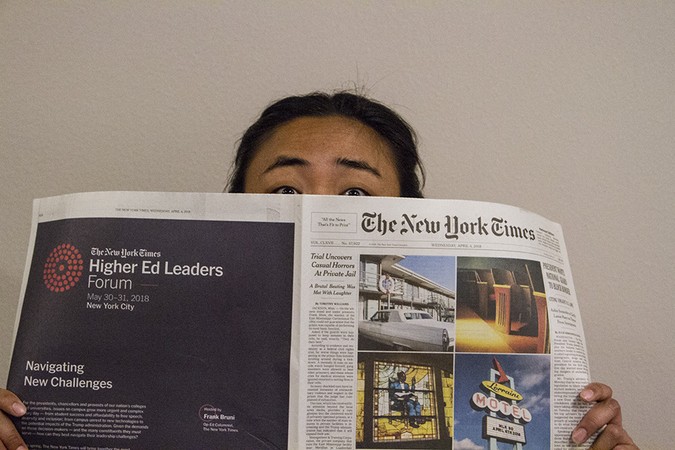A recent Student Government Association survey about a New York Timesproposal has shown students remain strongly split over the presence of the news source on campus.
A CONTENTIOUS ISSUE
SGA has funded New York Times papers for students for several years. However, during this school year students have expressed dissatisfaction with the amount of money SGA has invested in supplying papers. This included an OVERHEARD@BIOLA Facebook post in October in which students debated over the value of the publication. The same month, senators decreased the number of newspapers offered. Most recently, a divided senatorial vote passed a $1,380 proposal for 50 copies a day for five weeks, with the New York Times refunding SGA for any copies that students do not take.
The division stemmed from some senators’ concerns with the results of a survey SGA conducted to gauge interest in the New York Times. Out of 201 responses, 38.8 percent of students wanted SGA to pass the proposal, while 35.8 percent of students wanted SGA to deny it, with 23.4 percent wanting the funding to decrease.
SGA senior vice president Ella Corey believes the New York Times proposals have remained particularly contentious because they concern a tangible object, meaning students can directly see the results of their survey votes and therefore feel more involved.
“This proposal, I feel like, is pretty polarized. You see the students who really care about it don’t want it to be taken away, ” Corey said. “So people who regularly read it like to depend on it. However, people who don’t read it don’t care and they think it’s a waste of money.”
MOVING TO DIGITAL
Some classes require students to read newspapers, according to Corey. However, audiences often look to their smartphones and social media for their news, as some of the responses to the survey argued. She believes SGA should seek to provide students with better access to the online format, though she remains unsure how SGA would go about this.
Biola students are not the only demographic showing a preference for screens over print. A 2016 Pew Research Center survey showed 50 percent of Americans aged 18-29 who consumed the news did so through online formats, while only 5 percent used print newspapers.
Freshman biological science major Ana Norio Bran believes students’ access to mobile devices decreases the importance of physical newspapers.
“Especially in a world of technology, I think everything is mostly on a laptop or a phone,” Bran said.
STUDENTS CONTEST VALUE OF NEWS
Sophomore history major Daniel Su also believes he can access the internet if he wants to read the news, but does not feel news appeals to him in general and would prefer SGA spend their funds elsewhere.
“I think it’s just lack of interest [in news]. Like, I’ll keep up to date if [it’s] something really urgent or terrible that’s happened, but otherwise I don’t think I’ll look at the news every single day,” Su said.
Bran notes she would prefer to see the more local Los Angeles Times offered over the New York Times. SGA has looked into the possibility of bringing the Wall Street Journal to campus, but has not heard back from the publication, according to Corey.
Corey also believes Biola needs an outside news source, regardless of the publication.
“I believe as an academic institution, it’s part of our job to educate students and this is a small way we can take part in the education of students,” Corey said. “One of the big things we talked about in the [SGA] meeting was, this is a great way to connect Biola outside the bubble and plug us into the world around us and create dialogue on world issues.”








